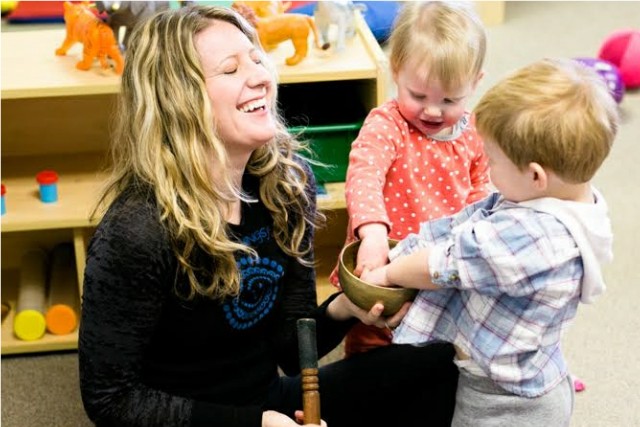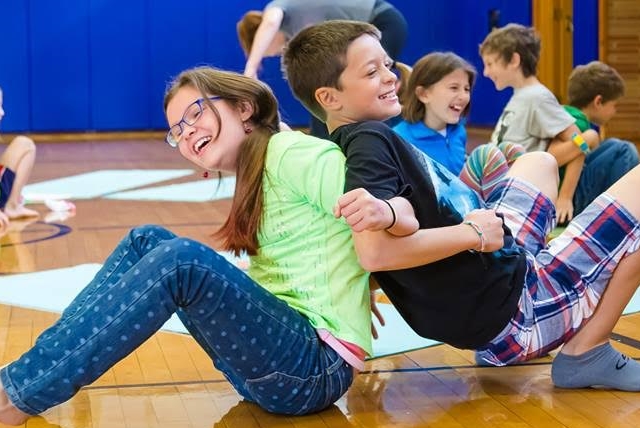*Disclaimer: Elephant Journal articles represent the personal views of the authors, and can not possibly reflect Elephant Journal as a whole. Disagree with an Op-Ed or opinion? We’re happy to share your experience here. This website is not designed to, and should not be construed to, provide medical advice, professional diagnosis, opinion or treatment to you or any other individual, and is not intended as a substitute for medical or professional care and treatment. For serious.
It has been a journey for me to look more closely at the severity of anxiety I experienced as a child and young adult—now I see how large a struggle life used to be for me.
Reflecting on my journey, I’ve come to realize that the protective cage I put myself into, as a child, was due to an inability to calm myself in uncomfortable situations.
Now, through my job, I have the opportunity to share stress management tools with youth, aged two through 18. While doing this, I find that many of them go through the same anxieties I did. I had always thought these anxieties were mine alone.
I remember not being able to raise my hand in school for fear of people looking at me and disliking Halloween, knowing my anxiety would be heightened from the self-consciousness of wearing a costume.
In second grade, the school had its annual assembly awarding students for perfect attendance during the year. I was one of them. My anxiety was so severe, instead of proudly accepting an award, I stayed home from school. All so I wouldn’t have to get up in front of hundreds of students!
I never went anywhere alone, and the thought of sleeping over at a friend’s house would make my stomach twist so badly that I would call home “sick.” Playing competitive sports led me to fake injuries just so I didn’t have to face the pressure. I wouldn’t go out to eat without knowing where the bathroom was for fear that I might have nausea from a nervous stomach.
Due to my anxiety, I knew I could never go away to college. I chose a school close to home and commuted. I needed to remain in my safe bubble and so lived at home longer than most post-graduate students. My own experiences led me to research anxiety and stress, and it has become evident to me that many people suffer in silence—just like me. I am not alone.
In the midst of my suffering, experiencing panic attacks while driving and at times lying on the living room floor with tears in my eyes, thinking “what is wrong with me and what can I do to help myself?”, I decided to ask my doctor for anti-anxiety medication. At this same time, I was diagnosed with ADD too and tried Ritalin for a few months. The results were awful. Side effects ranged from mood swings to an inability to truly feel emotion.
I decided to give yoga a try. While yoga wasn’t an instant fix—and there were times I would have to leave in the middle of class when my anxiety got the best of me—with practice and patience I saw a whole new Julie emerging. Soon after, I decided to take myself off my medications.
My practice of yoga and mindfulness gave me a new perspective. I was able to place myself in uncomfortable situations without what I would call “melting down.” Then I started to travel and to get further out of my comfort zone. I could go places on my own and travel the world! What a beautiful transformation to be able to shed layers of old patterns and beliefs about myself and address the root of my problems.
Now I still struggle with occasional anxiety but not in a way that inhibits my daily life as it did in the past. I have gained self-knowledge through my practice of yoga and mindfulness. I have learned to slow down, check in and develop clarity through my body, mind and breath. I have learned to eat in congruence with what my body processes most effectively. I have learned to breathe through discomfort and clearly hear my own self-talk.
These six tips helped me self regulate through my anxious moments.
- Responding vs reacting
When anxiety and stress hits hard, the breath can become shallow. When moments of discomfort arise, I breathe into these feelings. And by breathe, I mean taking huge deep breaths that go in through my nose, down into my belly and out through my mouth.
Taking at least five of these breaths signals to the nervous system that everything is going to be okay. My yoga practice taught me to breathe through uncomfortable postures that that, too, can be symbolized as uncomfortable moments in life. I remember my yoga teacher Tina Porter saying, “How you respond is up to you. We can either react to, or breathe into, the discomfort to make it easier on us.” We will always encounter uncomfortable situations in life; now I choose to respond rather than react.
- Self-Awareness
After taking deep, cleansing breaths, I try to notice where I am holding my stress. I tend to hold mine in my jaw, neck, temples and shoulders, so when I’m feeling overwhelmed, I give myself a little massage to release the tension. Through my yoga practice, I’m able to slow down, let my mind chatter subside and, by moving my body mindfully, assess where stress is stored and then release it.
- Diet
I know that my diet contributes greatly to my state of mind. For instance, I notice that my anxiety spikes when I have caffeine, lots of sugar, alcohol and processed foods. When I eat fresh fruits and vegetables, grains, seeds and nuts, the likelihood of anxiety is minimal. I notice that alcohol suppresses my anxiety in the moment but find, hours later, that my anxiety returns to start its talking to me.
Also I drink lots of water, which makes me feel like I am flushing out toxins and so replenishing my body. Yoga creates a mind/body connection that can be heard loud and clear. I believe yoga has given me the self-awareness and the tools to listen to what the mind and body are saying.
- Self-Compassion
I recall not being very kind to myself when I struggled with anxiety. I would beat myself up for avoiding certain activities. I felt that my shy nature was something I needed to “just get over.” My yoga practice helped me find compassion for my body and taught me how to do the same with my mind. If something hurt, I backed off. If I was tired, I would find child’s pose. Yoga helped me see patterns clearly on the mat, so that I was able to apply them off the mat.
- Self-Talk
When I am in a moment of panic, focusing on affirmations helps to stop my mind from running wild. When I’m feeling anxious, I stop and ask—what am I telling myself? If it’s negative self-talk, I count to 20 or repeat, “I am relaxed,” while taking deep breaths. This gives me a choice to either continue the pattern, or change the story.
- Gaining perspective
Traveling, and so leaving my comfort zone, was something built up in my mind as scary. Traveling across the country by myself? What if I had a panic attack? What if I got sick? What if I got lost? When I pushed myself out of my comfort zone, I realized that these “what ifs” rarely happened. I started to tackle my fears in small ways.
While I was afraid to travel on a plane alone, I started driving more places alone. And I would continue to listen to my mind’s chatter. If I felt anxious, I would back off and do something that made me feel comfortable. This is very similar to my yoga practice. If a posture is uncomfortable, I back off.
With a new trust in letting go of control, and being able to turn inward, I have been given the confidence I need to push through activities that, as a youth, I would have been unable to face during times of anxiety and stress. These tips have helped me to change my brain!
The desire to help share these tools is now deeply rooted in my heart and soul. I only wish I had been given them when I was younger. But, now, reaching younger generations is my dharma.
~
Author: Julie Campilio
Apprentice Editor: Laura G. Williams / Editor: Catherine Monkman
Images: Kelly Shroads Photography








Read 0 comments and reply